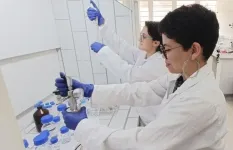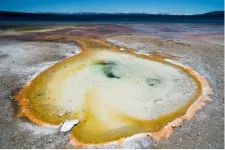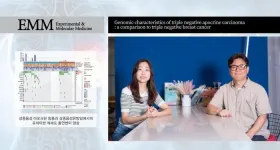(Press-News.org) Acetone is an essential chemical industry input and is used in the manufacturing of a wide array of products, such as adhesives, antibiotics, electronic components, solvents and removers, inks and vitamins, among others. Its production is complex and hazardous. To simplify the process and make it safer and cheaper, researchers in Brazil and Germany have developed an innovative method that uses only light and photoactive iron chloride (FeCl3), an inexpensive chemical compound.
An article on the research, which was funded by FAPESP, is published in the journal ACS Catalysis.
The standard acetone manufacturing process, known as the Hock or cumene process, comprises several stages. Propane, a petroleum product, is converted to propylene, a highly flammable gas, which is reacted with benzene and then with oxygen at high temperatures and pressures to give rise to acetone. These reactions also produce phenol, a compound for which there is less demand but which can be converted to value-added substances, although this is costly.
The alternative method developed by scientists affiliated with the Federal University of São Carlos (UFSCar) and the Federal University of Minas Gerais (UFMG) in Brazil, in collaboration with colleagues at the Max Planck Institute of Colloids and Interfaces in Germany, is based on propane oxidation and a photocatalytic reaction using iron chloride as a homogeneous catalyst in the presence of light.
“We discovered that when iron chloride is irradiated at certain wavelengths, it produces the radical chlorine, which is a potent oxidant and cleaves the bond between carbon and hydrogen [activates the C-H bond], giving rise to a radical that leads in the presence of oxygen to the formation of acetone,” said Ivo Freitas Teixeira, a professor in UFSCar’s Department of Chemistry and last author of the article. “We achieved a very important reaction in an absolutely different manner and using very simple elements.”
Proof that the reaction was genuinely driven by chlorine radicals produced by Fe-Cl photolysis was obtained by means of mechanistic studies, including mass spectrometry, an analytical technique that identifies the components of a mixture by determining the molecular weight of their particles.
Among the advantages of the process is the fact that it is direct – skipping the production of propylene in intermediate stages – and safer as it does not involve oxygen reactions at high temperatures and pressures or flammable and hazardous intermediaries. In addition, it lowers energy consumption and cost because it has fewer stages and occurs at room temperature (25 °C).
The experiments used light-emitting diodes (LEDs) as a light source, but the researchers plan to use sunlight instead in future, making the method even more sustainable.
Patent application and next steps
A patent application has been filed with the National Industrial Property Institute (INPI), Brazil’s patent office, and partnerships with companies are being sought to scale up and commercialize the new process. “It could become absolutely disruptive for acetone production in the chemical industry, enhancing safety and sustainability, and paving the way to direct production of acetone, which would cut costs and increase competitiveness,” Teixeira said.
The main challenges, he added, are the large scale of processes in the petrochemical industry, and the fact that as yet there are no commercial photocatalysis methods.
The research also continues to develop in two directions: testing of the new method with other substances, such as methane; and seeking ways to scale up the process so as to increase industrial production and yield.
About São Paulo Research Foundation (FAPESP)
The São Paulo Research Foundation (FAPESP) is a public institution with the mission of supporting scientific research in all fields of knowledge by awarding scholarships, fellowships and grants to investigators linked with higher education and research institutions in the State of São Paulo, Brazil. FAPESP is aware that the very best research can only be done by working with the best researchers internationally. Therefore, it has established partnerships with funding agencies, higher education, private companies, and research organizations in other countries known for the quality of their research and has been encouraging scientists funded by its grants to further develop their international collaboration. You can learn more about FAPESP at www.fapesp.br/en and visit FAPESP news agency at www.agencia.fapesp.br/en to keep updated with the latest scientific breakthroughs FAPESP helps achieve through its many programs, awards and research centers. You may also subscribe to FAPESP news agency at http://agencia.fapesp.br/subscribe.
END
A novel method to obtain acetone more simply, safely and cheaply
Acetone, a key input for the chemical industry, is usually produced by an elaborate and hazardous process. A more sustainable strategy has been developed by a scientific collaboration between researchers in Brazil and Germany.
2023-09-13
ELSE PRESS RELEASES FROM THIS DATE:
Life in boiling water
2023-09-13
Oak Ridge National Laboratory scientists studied hot springs on different continents and found similarities in how some microbes adapted despite their geographic diversity. The findings yield clues to the evolution of life and whether some of the hardiest microbes may be harnessed for biotechnology.
The study was the first of its kind to sample hot springs on three continents with water temperatures above 65 C (149 F) in the United States, Iceland and Japan. The environments have unique geology and chemistry, almost like a fingerprint, so it was surprising to find highly related microbes separated by thousands of miles, said ORNL’s Mircea Podar, co-lead of the ...
100-year floods could occur yearly by end of 21st century
2023-09-13
WASHINGTON — Most coastal communities will encounter 100-year floods annually by the end of the century, even under a moderate scenario where carbon dioxide emissions peak by 2040, a new study finds. And as early as 2050, regions worldwide could experience 100-year floods every nine to fifteen years on average.
A 100-year flood is an extreme water level that has a 1% chance of being exceeded in any given year and is based on historical data. Despite the name, 100-year floods can strike the same area multiple years in a row or not at all within a century. But a new study finds that those historical trends will no ...
How education, work and motherhood shape women’s life ‘pathways’
2023-09-13
A new study from North Carolina State University and Duke University offers insights into the ways that education, work and motherhood shape the lives of women in the United States. In a longitudinal study of more than 8,100 women, the researchers found seven “pathways” that illustrate the way major life events can have long-term ripple effects.
“Our goal here was to examine how family, work and education influence each other in the lives of women, rather than viewing education as a separate process from work and family,” says Anna Manzoni, co-author of a paper on the study and an associate professor of sociology ...
Matter comprises of 31% of the total amount of matter and energy in the universe
2023-09-13
“Cosmologists believe that only about 20% of the total matter is made of regular or ‘baryonic’ matter, which includes stars, galaxies, atoms, and life,” explains first author Dr. Mohamed Abdullah, a researcher at the National Research Institute of Astronomy and Geophysics-Egypt, Chiba University, Japan. “About 80% is made of dark matter, whose mysterious nature is not yet known but may consist of some as-yet-undiscovered subatomic particles.” (Fig. 1)
“The team used a well-proven technique to determine the total amount of matter in the universe, ...
Emily Rogalski joins UChicago to lead new center for healthy brain aging, Alzheimer's and related diseases
2023-09-13
The University of Chicago will launch a pioneering new center aimed at shifting the popular narrative around the physical and cognitive impacts of aging.
Headed by leading neuroscientist Emily Rogalski, PhD, the new University of Chicago Healthy Aging & Alzheimer's Research Care (HAARC) Center will focus on building deep multidisciplinary expertise and bridging the gap between scientific disciplines to accelerate breakthroughs in cognitive resilience.
“We want to increase awareness and the scientific probability ...
Illuminating the path to sustainable wellbeing
2023-09-13
IIASA is proud to announce the launch of its Flagship Report, "Systems Analysis for Sustainable Wellbeing. 50 Years of IIASA Research, 40 Years After the Brundtland Commission, Contributing to the Post-2030 Global Agenda” on Wednesday, 13 September 2023 at an official UN event in the framework of the 78th session of the UN General Assembly and the Sustainable Development Goals mid-term review.
The IIASA Flagship Report chronicles the extraordinary 50-year journey of IIASA, a globally renowned institute providing systems analytical expertise on complex global challenges. Co-sponsored by the Permanent Missions of Austria and South Africa ...
Study finds that state-mandated civics test policy does not improve youth voter turnout
2023-09-13
Washington, September 13, 2023—The United States has the largest age gap in voter turnout among advanced democracies. Youth voter turnout remained low, at 48 percent, in 2020. Scholars, educators, and policymakers often recommend civic education as a solution to low youth voter turnout.
However, new research finds that a commonly used state-mandated civics test policy—the Civics Education Initiative (CEI)—does not improve youth voter turnout, at least in the short term. The study, by Jilli Jung and Maithreyi Gopalan, both at Pennsylvania State University, was published today in Educational ...
Groundbreaking research unveils genetic characteristics and improved prognosis of triple negative apocrine carcinoma
2023-09-13
Breast cancer research takes a significant stride forward as Professor Semin Lee and his research team from the Department of Biomedical Engineering at UNIST, in collaboration with Professor Ji-Yeon Kim and Professor Young-Hyuck Im from the Division of Hematology-Oncology at Samsung Medical Center in Seoul, delves into the exploration of triple negative apocrine carcinoma. This rare breast cancer subtype has garnered attention due to its unique genetic characteristics and improved prognosis when compared to other forms of triple-negative breast cancer (TNBC).
Triple negative ...
Inflammatory signs for adolescent depression differ between boys and girls
2023-09-13
New research led by the Institute of Psychiatry, Psychology & Neuroscience (IoPPN) at King’s College London has found that depression and the risk of depression are linked to different inflammatory proteins in boys and girls.
When inflammation occurs in the body a host of proteins are released into the blood called cytokines. Previous research has shown that higher levels of cytokines are associated with depression in adults, but little is known about this relationship in adolescence.
Researchers investigated sex-differences in the relationship between inflammatory proteins and depression. Published in the Journal of ...
The effect of crowdsourcing contests on a company's stock and the idiosyncratic risks they create for investors
2023-09-13
Researchers from University of Colorado Denver, Iowa State University, and Arizona State University published a new Journal of Marketing study that examines the stock market effects on these contests and the contest characteristics that may enable such contests to pay off.
The study, forthcoming in the Journal of Marketing, is titled “When Do Marketing Ideation Crowdsourcing Contests Create Shareholder Value? The Effect of Contest Design and Marketing Resource Factors” and is authored by Zixia Cao, Hui Feng, and Michael A. Wiles.
Crowdsourcing contests for marketing ideas such as new ads, graphics, and products have become quite popular ...
LAST 30 PRESS RELEASES:
Chronic breathlessness emerging as a hidden strain on hospitals
Paleontologists find first fossil bee nests made inside fossil bones
These fossils were the perfect home for ancient baby bees
Not everyone reads the room the same. A new study examines why.
New research identifies linked energy, immune and vascular changes in ME/CFS
Concurrent frailty + depression likely boost dementia risk in older people
Living in substandard housing linked to kids’ missed schooling and poor grades
Little awareness of medical + psychological complexities of steroid cream withdrawal
Eight in 10 trusts caring for emergency department patients in corridors, finds BMJ investigation
NASA’s Webb telescope finds bizarre atmosphere on a lemon-shaped exoplanet
The gut bacteria that put the brakes on weight gain in mice
Exploring how patients feel about AI transcription
Category ‘6’ tropical cyclone hot spots are growing
Video: Drivers struggle to multitask when using dashboard touch screens, study finds
SLU research shows surge in alcohol-related liver disease driving ‘deaths of despair’
Rising heat reshapes how microbes break down microplastics, new review finds
Roots reveal a hidden carbon pathway in maize plants
Membrane magic: FAMU-FSU researchers repurpose fuel cells membranes for new applications
UN Member States pledge to increase access to diagnosis and inhaled medicines for the 480 million people living with COPD
Combination therapy shows potential to treat pediatric brain cancer ATRT
Study links seabird nesting to shark turf wars in Hawai‘i
Legal sports betting linked to sharp increases in violent crime, study finds
Breakthrough AI from NYUAD speeds up discovery of life-supporting microbes
New Eva Mayr-Stihl Foundation funding initiative boosts research at University of Freiburg on adaptation of forests to global change
The perfect plastic? Plant-based, fully saltwater degradable, zero microplastics
Bias in data may be blocking AI’s potential to combat antibiotic resistance
Article-level metrics would provide more recognition to most researchers than journal-level metrics
Satiety’s little helper: Protein that supports appetite regulating protein identified
UF dives deep into predicting storm damage with computer models
A stormy ocean voyage yields insights on the global carbon cycle
[Press-News.org] A novel method to obtain acetone more simply, safely and cheaplyAcetone, a key input for the chemical industry, is usually produced by an elaborate and hazardous process. A more sustainable strategy has been developed by a scientific collaboration between researchers in Brazil and Germany.




